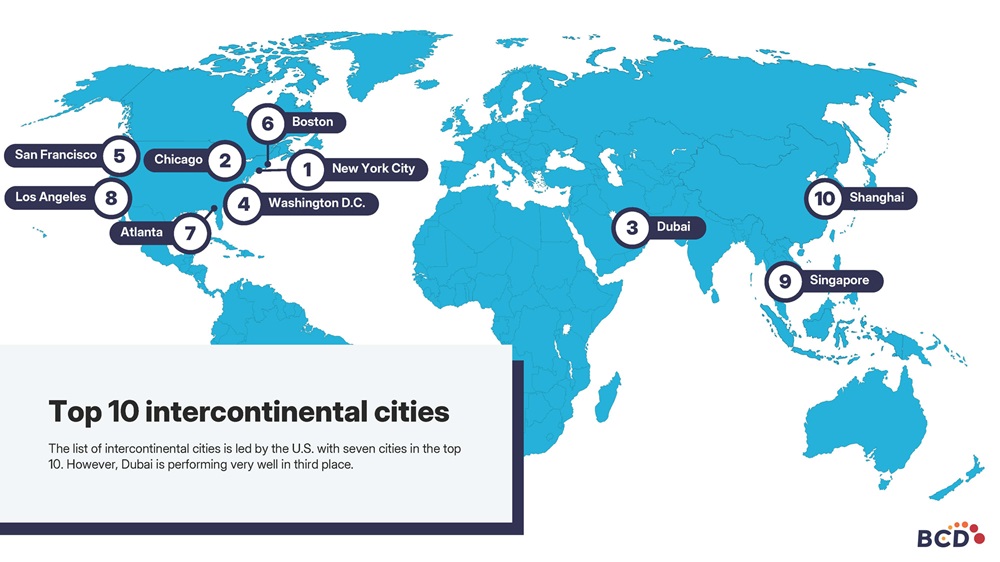Why read this report?
The trends in this report may be useful predictors of emerging business hubs, popular destinations, and up-and-coming markets. Together with the travel management company, travel program stakeholders should apply the information to business travel planning. By analyzing these trends, you may be able to better manage air, hotel and car rental spend and identify cost-effective destinations.

“Risks like geopolitics and rising crime, new sustainability legislation and remote work continue to impact business travel volumes and where travel budgets are directed to,” said Michèle Lawley, BCD’s president of Europe. “Airline capacities once sufficient might become scarce. A destination once safe might have become dangerous for travelers. These are some examples of why travel programs quickly need to adjust to new circumstances. We support our corporate clients by keeping them abreast of any developments, advising them on supplier negotiations, managing risks, and providing travelers with tools they like to use.”
Top 10 business travel cities
Overall, business travel spend in Europe in 2023 recovered to 96% of pre-pandemic (2019) levels. Western Europe is clearly a preferred destination, with eight of 10 cities on the intra-European list. The return of face-to-face meetings and events and the rebound in international business travel capacity and volumes may have lured travelers there. The rest of Europe is recovering slower, challenged by the war in Ukraine among other reasons.


The U.S. dominated the list of intercontinental cities, with seven cities in the top 10. Dubai took third place. Singapore and Shanghai rank ninth and tenth respectively, signaling growing activity for APAC this year.
“While global business travel rebounds, the pace of recovery in China has been more gradual,” said Jonathan Kao, managing director of North Asia. “Beijing has dropped off the list from its 2019 position as the eighth most visited intercontinental city for European business travelers, and Shanghai has fallen from second to 10th place. Despite this, we’re encouraged by the recent visa exemptions for travelers from certain European countries, and overall, more lenient visa procedures. We anticipate a significant resurgence in business travel to China in 2024, evidenced by the early increase in travel volumes we’ve seen in the first two months of 2024.”
2023 top business travel countries: Germany and U.K.
Germany is the most visited European country, followed by the United Kingdom which dropped from first place in 2019 to second in 2023. Post-Brexit, EU and Swiss citizens need a valid passport to travel to the U.K. and can no longer freely enter the country with a national ID card. Nevertheless, it remains a top destination for business travel. The Netherlands, France and Italy follow in third, fourth and fifth place, respectively.
The U.S. leads the intercontinental ranking, followed by the United Arab Emirates, India and China. This demonstrates the strong trading relationship between Europe and Asia.
Top 10 business travel routes
The most frequently traveled routes for intercontinental flights from Europe depart from London and Frankfurt, together accounting for eight positions in the top 10. Amsterdam and Paris complete the list of European departure hubs in ninth and tenth place.
The top 10 arrival hubs for intercontinental routes are largely dominated by the U.S., with New York City being the most popular. Shanghai is the only APAC arrival hub in the list.
Business travelers prefer business class for intercontinental flights
When looking at the cabin class European travelers booked for intercontinental flights in 2023, business class leads with 47%, followed by economy class with 42%. Premium economy accounts for 10% and first class for only 1%. This is slightly different from the results in a soon to be published report with insights about U.S. travelers, where business class and economy class make up for respectively 53% and 36% on intercontinental flights.
Direct vs. connecting flights
When traveling for business in Europe, 84% of booked flights are direct with only 16% as connecting flights. However, for intercontinental travel, the breakdown is almost equal: 51% of booked flights are direct, 49% are connecting flights.
“The chosen service class, type of flight and even the route have a direct effect on CO2 emissions,” Lawley added. “For example, direct flights offer a shorter route and use less fuel on landing and take-off than connecting flights. By analyzing their emissions data, companies can hone in on what behaviors or policies they want to influence or change to support smart and purposeful travel.”
More cars were rented in Germany than anywhere else
For 21% of all air bookings in Europe, travelers book a rental car with an average of four days. Germany leads the ranking for car rental with five cities in the top 10: Munich, Frankfurt, Stuttgart, Hamburg and Berlin. Other top 10 car rental cities include Paris, London, Amsterdam, Milan and Barcelona.
According to a recent BCD car rental survey of more than 900 business travelers worldwide, most business travelers rent a car to visit their company’s office, meet with clients or provide onsite service. The most common reasons for renting a car instead of using other means of transportation are convenience, speed, lack of alternatives and price. Intermediate/standard cars are rented most often, followed by compact/economy.
GET THE REPORTBCD annually tracks the rise and fall of business travel volumes as they can reflect the level and health of economic activity within a region or country. The Cities & Trends U.S. 2023 edition will publish soon.


